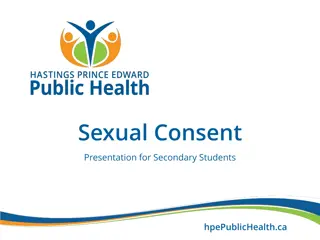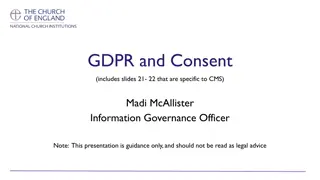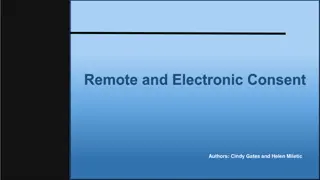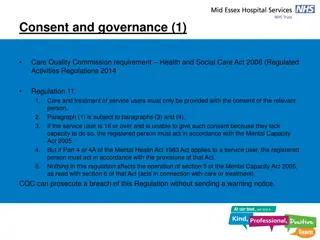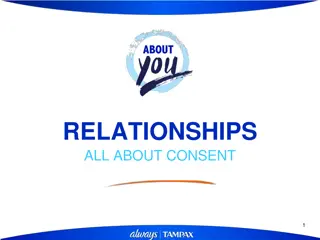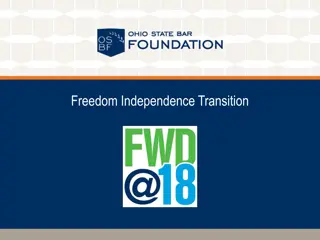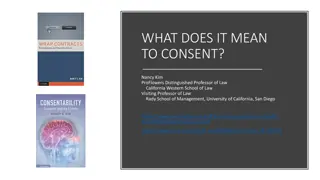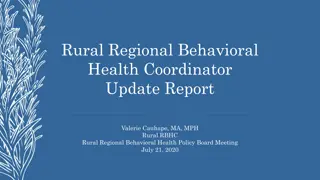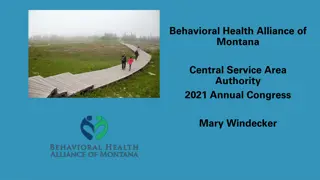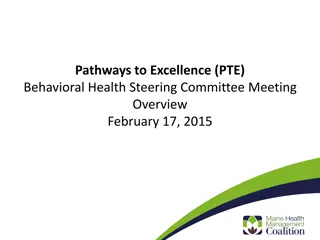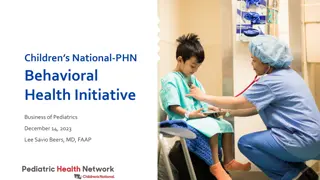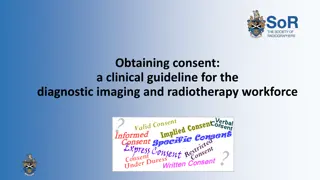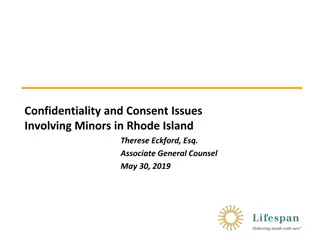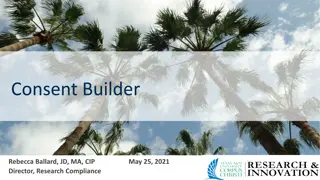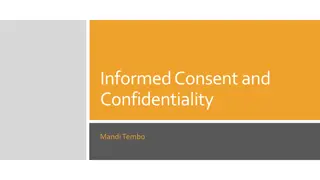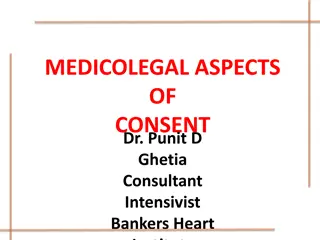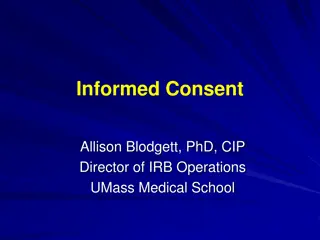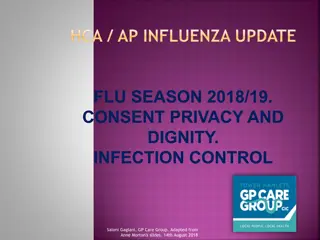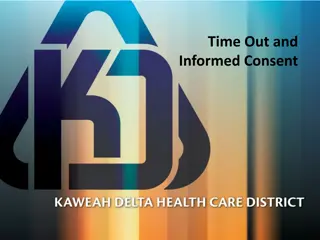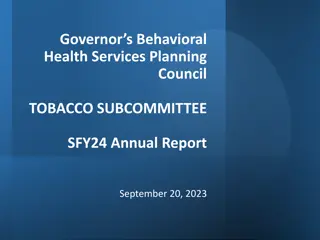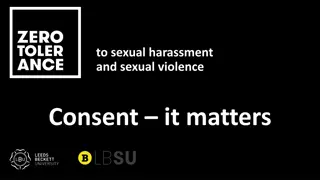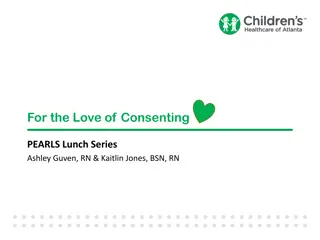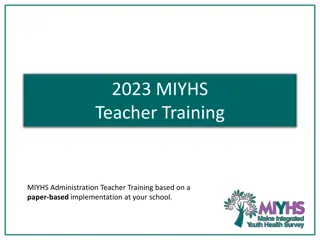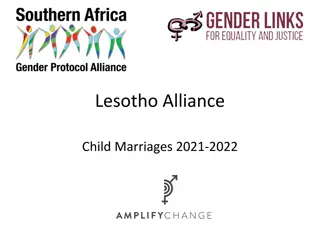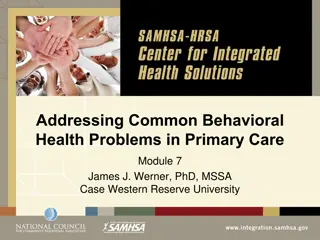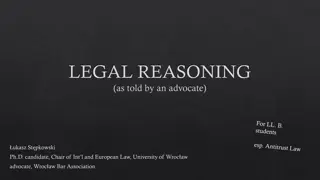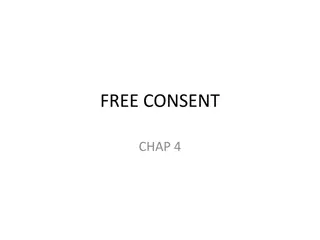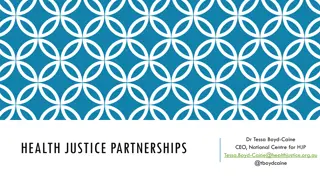Understanding Legal History: Age of Majority & Consent in Behavioral Health
Explore the significance of the age of majority, age of consent, and parent-initiated treatment in behavioral health settings. Learn about the distinctions and implications of these legal concepts on treatment decisions for minors, voluntary/involuntary status triggers, due process rights, and parent disclosures. Discover the evolution of age of majority laws from 1854 to present day, highlighting changes in rights and decision-making capacities for individuals.
Download Presentation

Please find below an Image/Link to download the presentation.
The content on the website is provided AS IS for your information and personal use only. It may not be sold, licensed, or shared on other websites without obtaining consent from the author. Download presentation by click this link. If you encounter any issues during the download, it is possible that the publisher has removed the file from their server.
E N D
Presentation Transcript
Legal History: Age of Majority, Age of Consent, and Parent- Initiated Treatment Kevin Black, staff coordinator/counsel Senate Committee Services May 20, 2018
Glossary of Terms Age of Majority Generally, the age, established by state law, at which a person is considered an adult. Depending on the state, this happens at some point between 18 and 21. Age of Consent Used here to mean an exception, created by state law, which allows a minor to assume adult authority to authorize a health care intervention before the age of majority is reached. Minor-Initiated Treatment Term in behavioral health that describes what happens when a minor aged 13-17 uses the age of consent laws to start a course of voluntary treatment without the consent of the parent being required. Parent-Initiated Treatment An exceptional procedure authorized by Washington state law in which a parent or guardian may request a behavioral health evaluation and/or inpatient treatment for a non-consenting minor aged 13-17 without invoking involuntary treatment laws.
Why are these distinctions important? Voluntary or involuntary status triggers due process rights, court processes, and a right to counsel. Federal law defers to the law of each state to determine both the age of majority and the circumstances which require disclosures to parents relating to treatment of a minor. Rules implementing HIPAA look specifically to the age of consent to determine whether to consider a parent to be the personal representative of the minor; that is, a person who is entitled to view medical records without a signed release and make treatment decisions on behalf of the minor. Medical clinics (and their legal departments) prefer clear rules to help them determine whether a person s treatment is voluntary or involuntary, and whether or not a person has the legal capacity or competency to make their own decisions with respect to treatment decisions.
Age of Majority A look back
Meeting Place of Washington Territorial Legislature, 1854-1856
The Rules Change Slowly The language of the first age of majority statute was unaltered until 1923, when the age of majority was fixed at 21 for both genders. In 1970, certain rights were granted to persons at age 18, including the right to make decisions in regard to their own body and the body of their lawful issue In 1971, the present wording was adopted: Except as otherwise specifically provided by law, all persons shall be deemed and taken to be of full age for all purposes at the age of eighteen years. RCW 26.28.010. Age of consent laws are the laws that have evolved through case law, initiative, and legislation to otherwise specifically provide alternate ages for specific purposes. These have evolved in four discreet areas: testing for sexually transmitted diseases, provision of reproductive health care, mental health treatment, and substance use disorder treatment.
Age of Consent Where did these rules come from?
Diagnosis and Treatment of Sexually Transmitted Diseases In 1969, the Legislature established 14 as the age of consent for diagnosis/treatment of a sexually transmitted disease. This law provides that consent of parent or guardian is unnecessary, and the parent or guardian cannot be liable in payment for care rendered. RCW 70.24.110.
Reproductive Health Care In 1975, two years after Roe v. Wade, the Washington State Supreme Court found that the constitutional interests of minors give them a right to provide consent to receive an abortion without parental consent. State v. Koome, 84 Wn.2d 901. This was followed in 1992 by Initiative No. 120, which created a fundamental right to privacy under state law with respect to personal reproductive decisions, including birth control and abortion. This initiative was enacted by a public vote of 50.04% to 49.96%, and has never been amended.
Age of Consent for Behavioral Health Today, the age of consent is 13 for inpatient (RCW 71.34.500) and outpatient (RCW 71.34.530) behavioral health treatment. How did we get here, and why? Much has changed in what state government does to treat addiction, alcoholism, chemical dependency, mental health, substance use disorders, behavioral health disorders, since the earliest laws on this subject were codified in the 1950s.
Mental Health Age of Consent--History In 1951, the Mental Health Hospitalization Act was enacted. It liberally supported institutionalization for persons who are in need of care and treatment for mental illness.
Mental Health Hospitalization Act of 1951, continued The act established three state hospitals, Western, Eastern, and Northern State Hospitals, each under the direction of a superintendent (who must be a skillful practicing physician ) with control of the patients medical, therapeutic, and dietetic treatment, including authority to cause the performance of all necessary surgery. The superintendent was authorized to receive and detain any person who is, in the superintendent s opinion, a suitable person for care and treatment as mentally ill, or for observation as to the existence of mental illness, upon receipt of written application by the adult patient, the parent of a minor, or a guardian. All such patients were deemed voluntary patients. Minors would be released upon attaining the age of majority, unless they applied on their own as voluntary patients at that time. Voluntary treatment had a one-year time limit. Minors were required to be released within 12 days of a parental request, unless an involuntary court order was sought. An involuntary treatment court order, if obtained, would result in indefinite hospitalization at a state hospital until released by the superintendent thereof.
Reform Begins in 1973: the Involuntary Treatment Act Former RCW 72.23.070 was amended in first special session, 1973, to remove overt references to the ultimate authority of the superintendent of a state hospital, and to specify the rights of voluntary and involuntary patients. It was amended again in second special session, 1973, to require county mental health professional review of all applications for voluntary state hospital admission. This professional was required to provide a written report and evaluation stating whether voluntary treatment is necessary and proper and evaluating the reasons for voluntary treatment. Related image
1974: Minor Consent First Required, Starting at Age 13 In 1974, for the first time, references to commitment in a state hospital were changed to a public or private facility. The following restraint was enacted: applications for voluntary treatment of a minor, when such person is more than thirteen years of age, must be accompanied by the written consent, knowingly and voluntarily given, of the minor. Why was this done? It is unclear. A handwritten note in the margins of the archives file says *pertains to the rights of the minor. A transcribed floor speech on final passage of the bill (HB 1525) doesn t mention minors at all. It indicates that the overall thrust of the bill is correcting manifest problems and loopholes with the involuntary treatment laws passed in 1973.
1985: Age of Consent Law Fully Formed ESSB 3099 (1985), sponsored by Senator Phil Talmadge, created the modern age of consent statute for mental health treatment. This was part of a massive recodification of children s mental health laws into chapter 71.34 RCW. Existing laws were considered inadequate according to numerous file references, and the bill was developed by a work group comprised of assistant attorneys general in 1983. This was a 38 section, omnibus bill. Sec. 3: Any minor thirteen years or older may request and receive outpatient treatment without the consent of the minor s parent.
Did the 1985 Legislature Know What It Was Doing? There is no discussion of the policy change relating to minor age of consent in bill reports, staff memos, or constituent letters. There was no con testimony indicated in any of the policy committee hearings. Vote counts on final passage were 90-6 in the House and 43-5 in the Senate. However, a minority report in the House policy committee, signed by Representatives West, Dobbs, and Padden, says Children 13 years old are too immature to fully appreciate the ramifications of self-commitment to mental health facilities. The overall House committee vote was 12-3. The Senate committee vote was unanimously in favor. The archived bill file contains no indication that policy makers other than the dissenting House committee members focused on this change. Audiotape of floor speeches, if available, might reveal the extent to which this issue was discussed, or not discussed, on final passage.
Substance Use Disorder Age of Consent SUD age of consent statutes have a separate lineage, but have now been merged with mental health age of consent statutes, effective April 1, 2018, by E3SHB 1713, 261, which largely repealed former chapter 70.96A RCW and incorporated what was formerly termed chemical dependency into statutes relating to mental health, under the new umbrella of behavioral health. This had the effect of erasing differences between former age of consent statutes, expanding SUD age of consent provisions to include ability to consent to inpatient SUD treatment, and applying parental notice provisions to SUD which were previously applicable only to minor-initiated inpatient mental health treatment. The former SUD age of consent statute, RCW 70.96A.095, has antecedents which I was able to trace back to 1971, and may go back further.
Parent-Initiated Treatment A slow development
Some Dissention Emerges Around Age of Consent Measure Sponsor Provisions Related to AOC for Mental Health Services Disposition SSB 5973 (1989) HB 3014 (1990) E2SHB 1417 (1995) Saling O'Brien Carrell Raises AOC from 13 to 16 Raises AOC from 13 to 15 Raises AOC from 13 to 14 Died in Senate Rules Not heard Passed House; struck by Senate; died in conference SHB 1255 (1995) Padden Requires parental notification when a minor accesses mental health services Died in House Rules 2SHB 1034 (1997) Mulliken Eliminates AOC unless minor is emancipated Died in House Rules SB 5166 (1997) Stevens Eliminates AOC unless minor is emancipated Not heard HB 2371 (2002) HB 1070 (2003) HB 1320 (2003) HB 1965 (2004) SB 5546 (2009) Delvin Delvin Delvin Delvin Haugen Raises AOC from 13 to 16 Raises AOC from 13 to 16 Raises AOC from 13 to 16 Raises AOC from 13 to 16 Allows parental access to a minor's mental health treatment records Not heard Not heard Died in House Rules Not heard Died in Senate Rules
Origins of PIT law in the Becca Bill On October 17, 1993, Rebecca Hedman was murdered at the age of 13 years old. She was described in contemporary news accounts as having engaged in prostitution to support a crack cocaine addiction, after running away from home at age 12. A Special Legislative Juvenile Justice Task Force was created in 1994 to recommend changes to juvenile justice laws, but reached no recommendations. A Non-Offender Subgroup, chaired by Sen. Jim Hargrove and Rep. Cathy Wolfe, reached four recommendations, which formed the basis of E2SSB 5439 (1995), the Becca Bill.
Becca Bill Provisions The Becca Bill had a strong focus on runaway and truant youth. It created secure and semi-secure crisis residential centers, at-risk youth (ARY) and child in need of services (CHINS) petition processes, a runaway child registry, and formalized truancy processes imposed on school districts involving community truancy boards and juvenile court intervention when efforts at truancy abatement are not successful. The Becca Bill also changed the age of consent for mental health by allowing parents to voluntarily admit a minor for inpatient mental health treatment without the consent of a minor. A CDMHP could review the admission for appropriateness between 15-30 days following admission, and DSHS was required to review the admission within 60 days.
1996: Age of Consent Provisions Struck Down by Washington Supreme Court T.B., 15 years old, was admitted by her parents to Fairfax Hospital in involuntary restraints, following a series of events including violent outbursts, runaways, a suicide attempt, arrest, truancy, drug use, and contraction of an STD. She refused to cooperate with mental health treatment. Despite these concerning events, criteria for involuntary commitment were not satisfied. The court s opinion fractured without a single majority, and avoided deciding the constitutional issues. Two plurality opinions found that the statutory requirements were unclear, disagreed about what those requirements were, but nevertheless agreed that the requirements had not been followed. Although the case was not decided on constitutional grounds, the plurality opinions express deep skepticism that T.B. could legally be held for treatment without court process. The lead opinion, signed by four justices, frames the issue as whether a child may be involuntarily incarceratedin a mental hospital by her parents and hospital staff without judicial oversight. The second opinion, also signed by four justices, is more sympathetic to the parents but reasons that since an unwilling child admitted by her parent cannot be a voluntary admittee, she must be an involuntary admittee. The statutory provisions governing involuntary admittees must be applied. State v. CPC Fairfax Hospital, 129 Wn.2d 439 (1996).
1997: The Next Skirmish The next year, the Legislature passed ESSB 5082 (1997) by large majorities. This bill abandoned the effort to directly change the age of consent, and instead created a parent-initiated treatment process, incorporating the concept of medical necessity, and providing for 30- day independent administrative reviews. After the third review, a court petition was required to continue treatment. Governor Gary Locke vetoed ESSB 5082 in its entirety, citing 100 days as too long before a minor placed in treatment would have access to courts.
1998: Parent-Initiated Treatment Passes The next year, SSB 6208 (1998) passed and sustained only a partial veto, establishing and enacting the modern parent-initiated treatment statute. The provider community failed to respond with enthusiasm.
Usage Changes in 2011 Despite further bills in 2005 and 2007, only two documented admissions for parent-initiated treatment occurred during the 12-year period between the law s effective date in 1998 and October 2011. What changed? It appears new legislation inspired a reevaluation among certain providers, starting with Seattle Children s Hospital. SSB 5187 (2011), brought forward by Sen. Randi Becker on behalf of the Binion family, required emergency rooms and inpatient facilities to document that they are informing parents verbally and in writing about parent-initiated treatment options, subject to civil penalties and adverse licensure action for noncompliance. DSHS records indicate that usage of PIT began to grow dramatically, starting in November 2011.
Use of Parent-Initiated Treatment Total minor inpatient psychiatric admissions Year # of PIT admissions # of PIT physician reviews Percent of inpatient admissions attributable to PIT 2006-Oct. 2011 2 2 ~4,431 0% Nov 2011-Dec 2011 13 3 ~165 8% 2012 140 18 1,001 14% 2013 227 28 1,073 21% 2014 354 62 1,166 30% 2015 424 42 1,589 27% 2016 377 38 Not available Not available
Recent Activity SSB 5706 (2017) was introduced, calling for expansion of PIT to incorporate outpatient treatment and recognition of the parent as personal representative of the minor. It passed out of committee but did not receive a floor vote in the Senate. E2SHB 2779 (2018) was adopted, calling for the formation of this advisory work group, and the development of recommendations.


